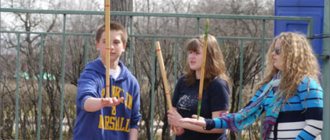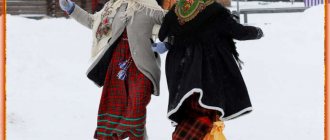Card index of folk outdoor games for middle group children
Transcript
1 State budgetary educational institution of Moscow “School 1874” (preschool department of M-la Novikova, 4, building 3) Card file of folk outdoor games for children of the middle group
2 Folk games in kindergarten are not entertainment, but a special method of involving children in creative activities, a method of stimulating their activity. While playing, the child learns about the world around him. By learning and using folk texts and songs in games and round dances, he fills them with specific content in relation to game situations. Learns the values and symbols of the culture of his people. The game teaches the child what he can do and what he is weak in. While playing, he strengthens his muscles, improves perception, masters new skills, gets rid of excess energy, experiences different solutions to his problems, and learns to communicate with other people. The game is a unique phenomenon of universal human culture. Through play, a child receives a variety of information about the world and himself from adults and peers. Russian folk culture is extremely rich in games: self-expression of buffoons, guslars, cockfights, puppet Parsley, bear baiting, horse racing, round dances, fist fights, whip competitions, active entertainment is a universal form of human behavior.
3 They develop a stable, interested, respectful attitude towards the culture of their native country, creating an emotionally positive basis for the development of patriotic feelings. Russian folk games have a long history; they have survived to this day from ancient times, passed on from generation to generation, absorbing the best national traditions. Boys and girls gathered outside the outskirts, danced in circles, sang songs, played burners and tag, and competed in dexterity. In winter, entertainment was of a different nature: there were rides from the mountains, snowball fights, horseback riding through the villages with songs and dances. Funny active folk games are our childhood. Who doesn’t remember the constant hide and seek, tag, and traps! When did they arise? Who invented these games? There is only one answer to this question: they were created by the people just like fairy tales and songs. Both we and our children love to play Russian folk games. Therefore, folk games in kindergarten are an integral part of the multicultural, physical, and aesthetic education of children. The joy of movement is combined with the spiritual enrichment of children. Funny active folk games are our childhood. Who doesn’t remember the constant hide and seek, tag, and traps! When did they arise? Who invented these games?
4 There is only one answer to this question: they were created by the people just like fairy tales and songs. Both we and our children love to play Russian folk games. Russian folk games reflect the people's love for fun, movement, and daring. There are games - fun with inventing absurdities, with funny movements, gestures, “buying forfeits.” Jokes and humor are characteristic of these games. Russian folk games are valuable for children from a pedagogical point of view: they pay great attention to the development of the mind, character, will, and strengthen the child. What is the advantage of using Russian folk outdoor games? Folk games help to assimilate the knowledge gained in the classroom: for example, to consolidate the idea of colors and shades, my children and I play the game “Paints.” Children really like the game. It contains the originality of game actions: dialogic speech, dialogue between the “monk” and the “salesman,” jumping on one leg and a poetic text. Folk games have a lot of humor, competitive fervor, movements are precise and imaginative, often accompanied by unexpected moments, children’s favorite rhymes and barkers. Children know a lot of counters and barkers. And by learning them by heart, we not only instill a love for Russian creativity, but also develop children's memory.
5 Russian folk game “Geese and Swans” Objectives: practice running while dodging. Description: Participants in the game choose a wolf and an owner, the rest are geese and swans. On one side of the site they draw a house where the owner and geese live, on the other there lives a wolf under the mountain. The owner lets the geese out into the field to take a walk and browse some green grass. Geese go quite far from home. After some time, the owner calls the geese. There is a roll call between the owner and the geese: Gushigusi! Ga-ga-ga. Do you want to eat? Yes Yes Yes. Swan geese! Home! Gray wolf under the mountain! What is he doing there pinching Ryabchikov? Well, run home! The geese run into the house, the wolf tries to catch them. Those caught leave the game. The game ends when almost all the geese are caught. The last remaining goose, the most agile and fastest, becomes a wolf. Rules: Geese must “fly” throughout the entire area. The wolf can catch them only after saying: “Well, run home!”
6 Russian folk game “At the Bear in the Forest” Objectives: To teach children to alternately perform different functions (run away and catch). Material: Mushrooms, berries, baskets, bear mask. Progress of the game: The bear's den (at the end of the site) and the children's house at the other are determined. Children go for a walk in the forest and perform movements according to the verse, which they recite in chorus: From a bear in the forest, I take mushrooms and berries, But the bear does not sleep and growls at us. As soon as the children finished saying the poem, the bear gets up with a growl and catches the children, they run home.
7 “Golden Gate” Objectives: Develop, develop speed, dexterity, eye, improve orientation in space. Practice walking in a chain. Description: A pair of players stand facing each other and raise their hands up - this is the goal. The remaining players take on each other so that a chain is formed. All the children say: Ay, people, ay, people, We intertwined our hands. We raised them higher, the result was beauty! It turned out to be no ordinary Golden Gate! The gate players say a rhyme, and the chain must quickly pass between them. Children of the “gate” say: the golden gate does not always let you through. The first time it is forgiven, the second time it is forbidden. But the third time we will let you through! With these words, hands drop and the gates slam shut. Those that are caught become additional gates. The "Gate" wins if they manage to catch all the players. Rules of the game: The game continues until there are three or four players left who have not been caught; you must lower your hands quickly but carefully.
8 Russian folk game “Burn, burn clearly!” Goal: to develop children's self-control and spatial orientation. Practice running fast. Description of the game: players stand in a column in pairs. A line is drawn in front of the column at a distance of 2-3 steps. The “catcher” stands on this line. Everyone says: Burn, burn clearly, so that it doesn’t go out. Look at the sky - Birds are flying, Bells are ringing! One, two, three run! After the word “run,” the children standing in the last pair run along the column (one on the left, the other on the right, trying to grab the hands in front of the catcher, who tries to catch one of the pair before the children have time to meet and join hands. If the catcher manages to do this , then he forms a pair and stands in front of the column, and the remaining one is the catcher.
9 “Burners with a handkerchief” Objectives: To develop in children the ability to act on a signal and practice running. Description: Players stand in pairs, one behind the other. The driver is in front, holding a handkerchief in his hand above his head. All in unison: burn, burn clearly, so that it doesn’t go out. Look at the sky, Birds are flying, Bells are ringing! One two Three! Last couple run! The children of the last pair run along the column (one on the right, the other on the left). The one who reaches the driver first takes a handkerchief from him and stands with it in front of the column, and the latecomer is on fire, that is, he leads.
10 “Kite” Objectives: To develop in children the ability to act on a signal, to practice running in different directions. Description: Roles are assigned among the players. One of them becomes a “kite”, another a “hen”, all the rest are “chickens”. The “chickens” line up in a column one at a time behind the “hen,” holding each other’s belts. The game begins with a dialogue: - Kite, kite, what's wrong with you? - I lost my shoes. - These? (“the hen”, and after her the “chickens” put their right leg to the side. - Yes! The “kite” answers and rushes to catch the “chickens”. The “hen” at the same time tries to protect the “chickens” without pushing the “kite” . The caught "chicken" leaves the game. Option: The caught "chicken" becomes a "kite"
11 “Frogs in the Swamp” Objectives: To develop in children the ability to act on a signal, to practice jumping on two legs. Description: The banks are outlined on both sides, and there is a swamp in the middle. There is a crane on one of the banks (beyond the line). The frogs sit on the hummocks (circles at a distance of 50 cm) and say: Here the frogs jump into the water from the wet rotten hill. They began to croak from the water: Kwa-ke-ke, kwa-ke-ke It will rain on the river. With the end of the words, the frogs jump from the hummock into the swamp. The crane catches those frogs that are on the hummock. The caught frog goes to the crane's nest. After the crane catches several frogs, a new crane is chosen from those who have never been caught. The game resumes.
12 “The Lame Fox” Objectives: Exercise children in running in circles and jumping on one leg. Description: Children choose “Lame Fox”. At the place chosen for the game, a fairly large circle is drawn, which includes all the children except the “fox”. At this signal, the children rush to run in a circle, and at this time the fox jumps on one leg and tries at all costs to touch one of the runners with his hand. As soon as she succeeds, she enters the circle and joins the rest of the running children, while the victim takes on the role of the “fox.” The children play until everyone is in the role of a lame fox; the game, however, can be stopped earlier, at the first sign of fatigue. Rules: Children who enter the circle must run only in it and not go beyond the outlined line, in addition, the participant chosen by the fox must run on only one leg.



